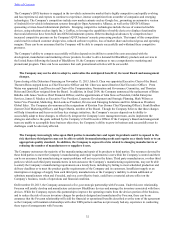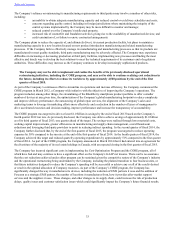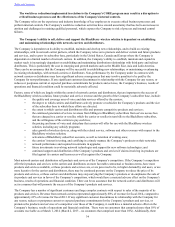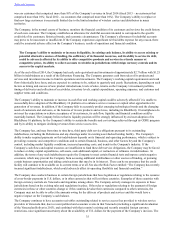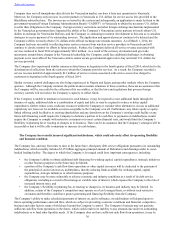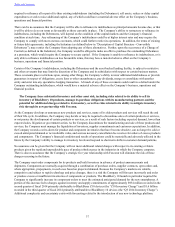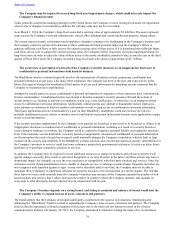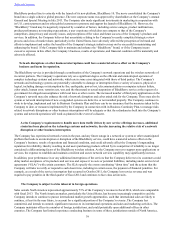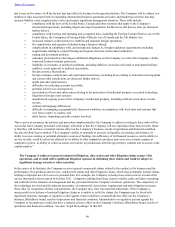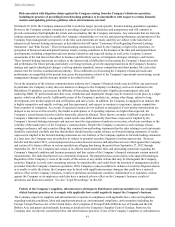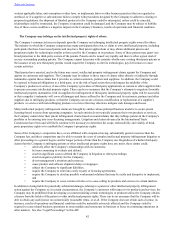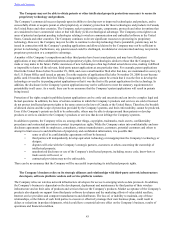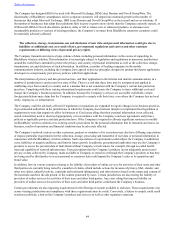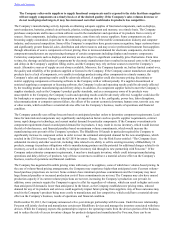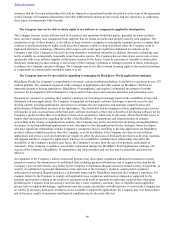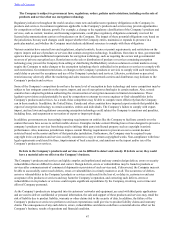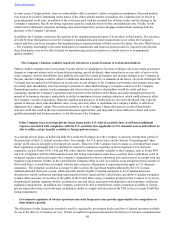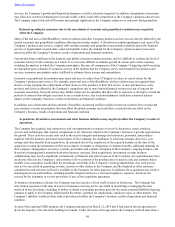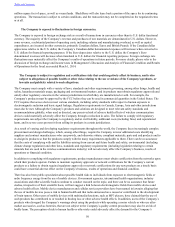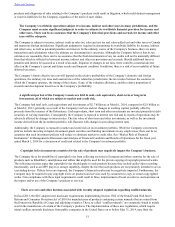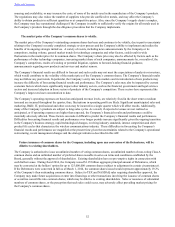Blackberry 2014 Annual Report Download - page 50
Download and view the complete annual report
Please find page 50 of the 2014 Blackberry annual report below. You can navigate through the pages in the report by either clicking on the pages listed below, or by using the keyword search tool below to find specific information within the annual report.
42
violates applicable labor, anti-corruption or other laws, or implements labor or other business practices that are regarded as
unethical, or if a supplier or subcontractor fails to comply with procedures designed by the Company to adhere to existing or
proposed regulations, the shipment of finished products to the Company could be interrupted, orders could be canceled,
relationships could be terminated, the Company’s reputation could be damaged, and the Company may be subject to liability.
Any of these events could have a negative impact on the Company’s business, results of operations and financial condition.
The Company may infringe on the intellectual property rights of others.
The Company’s commercial success depends upon the Company not infringing intellectual property rights owned by others.
The industry in which the Company competes has many participants that own, or claim to own, intellectual property, including
participants that have been issued patents and may have filed patent applications or may obtain additional patents and
proprietary rights for technologies similar to those used by the Company in its products. Some of these patents may grant very
broad protection to the third-party owners of the patents. Patents can be issued very rapidly and there is often a great deal of
secrecy surrounding pending patents. The Company cannot determine with certainty whether any existing third-party patents or
the issuance of any new third-party patents would require the Company to alter its technologies, pay for licenses or cease
certain activities.
Third parties have asserted, and in the future may assert, intellectual property infringement claims against the Company and
against its customers and suppliers. The Company may be subject to these types of claims either directly or indirectly through
indemnities against these claims that it provides to certain customers, partners and suppliers. In addition, the Company could
be exposed to financial obligations to a third party, or to the risk of legal action that could impact the salability of the
Company’s products or services, if one of the Company’s providers of third-party applications or content or other suppliers fails
to procure necessary intellectual property rights. There can be no assurance that the Company’s attempts to negotiate favorable
intellectual property indemnities with its suppliers for infringement of third-party intellectual property rights will be successful
or that a supplier’s indemnity will cover all damages and losses suffered by the Company and its customers, partners and other
suppliers due to infringing products, or that the Company can secure a license, modification or replacement of a supplier’s
products or services with non-infringing products or services that may otherwise mitigate such damages and losses.
Many intellectual property infringement claims are brought by entities whose principal business model is to secure patent
licensing-based revenue from operating companies. As such entities do not typically generate their own products or services,
the Company cannot deter their patent infringement claims based on counterclaims that they infringe patents in the Company’s
portfolio or by entering into cross-licensing arrangements. Litigation and claims advanced in the International Trade
Commission have been and will likely continue to be necessary to determine the scope, enforceability and validity of third-
party proprietary rights or to establish the Company’s proprietary rights.
Some of the Company’s competitors have, or are affiliated with companies having, substantially greater resources than the
Company has, and these competitors may be able to sustain the costs of complex intellectual property infringement litigation or
other proceedings to a greater degree and for longer periods of time than the Company can. Regardless of whether third-party
claims that the Company is infringing patents or other intellectual property rights have any merit, these claims could:
• adversely affect the Company’s relationships with its customers;
• be time-consuming to evaluate and defend;
• result in significant costs to defend the Company in litigation or other proceedings;
• result in negative publicity for the Company;
• divert management’s attention and resources;
• cause product and software shipment delays or stoppages;
• subject the Company to significant liabilities;
• require the Company to enter into costly royalty or licensing agreements;
• require the Company to develop possible workaround solutions that may be costly and disruptive to implement;
and
• require the Company to cease certain activities or to cease selling its products and services in certain markets.
In addition to being liable for potentially substantial damages relating to a patent or other intellectual property infringement
action against the Company or, in certain circumstances, the Company’s customers with respect to its products and services, the
Company may be prohibited from developing or commercializing certain technologies or products unless the Company obtains
a license from the holder of the patent or other intellectual property rights. There can be no assurance that the Company will be
able to obtain any such license on commercially reasonable terms, or at all. If the Company does not obtain such a license, its
business, results of operations and financial condition could be materially adversely affected and the Company could be
required to cease related business operations in some markets and restructure its business to focus on continuing operations in
other markets. See also “Legal Proceedings” in this AIF.
Table of Contents


